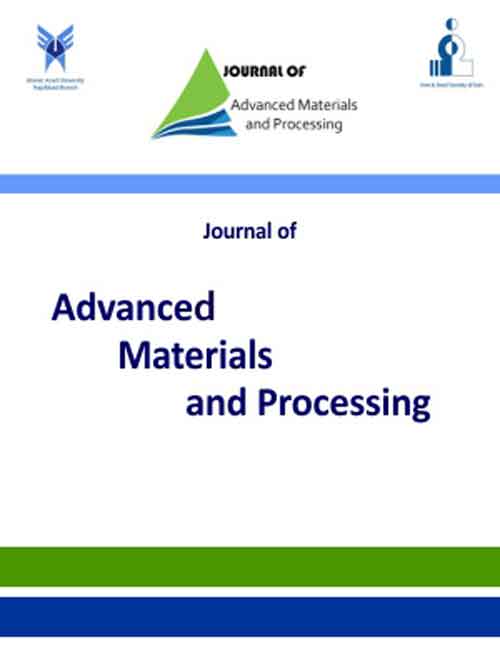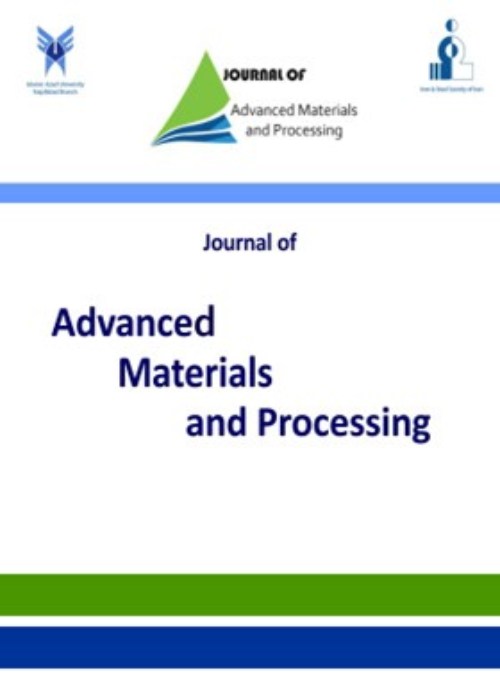فهرست مطالب

Journal of advanced materials and processing
Volume:4 Issue: 2, Spring 2016
- تاریخ انتشار: 1395/04/29
- تعداد عناوین: 6
-
-
Editorial BoardPages 1-2
-
Pages 3-20The present paper provides a semi-analytical solution to obtain the displacements and stresses in a functionally graded material (FGM) rotating thick cylindrical shell with clamped ends under non-uniform pressure. Material properties of cylinder are assumed to change along the axial direction according to a power law form. It is also assumed that the Poissons ratio is constant. Given the existence of shear stress in the thick cylindrical shell due to material and pressure changes along the axial direction, the governing equations are obtained based on first-order shear deformation theory (FSDT). These equations are in the form of a set of general differential equations with variable coefficients. Given that the FG cylinder is divided into n homogenous disks, n sets of differential equations with constant coefficients are obtained. The solution of this set of equations, applying the boundary conditions and continuity conditions between the layers, yields displacements and stresses. The problem was also solved, using the finite element method (FEM), the results of which were compared with those of the multi-layered method (MLM). Finally, some numerical results are presented to study the effects of applied pressure, non-homogeneity index, and power law index of FGM on the mechanical behavior of the cylindrical shell.Keywords: Thick cylindrical shell, Functionally graded material (FGM), Multi, layered method (MLM), Longitudinal variation of properties, Non, uniform pressure
-
Pages 21-28This study presents a new mechanical tube cladding process named punch plastic deformation pipe cladding (PPDPC) based on local deformation by pressing a punch into the inner layer of the bimetal tube. To investigate the capability of the process, stainless steel tube (as the inner layer) is bonded to a carbon steel pipe (as the outer layer) to fabricate a bimetal pipe. Shear punch tests were used to evaluate the bond strength between layers. Also, optical microscopy (OM) was employed to investigate the bonding interface. Experimental results showed an excellent bonding at the interface of two layers. Shear punch test results showed that the bonding achieved from this new method is stronger than the conventional thermo-hydraulic cladding method. This process is influenced by several parameters including punch diameters, punch nose radius and the friction coefficient between the punch and cladding tube. The effects of these parameters were evaluated by finite element (FE) analysis. Good bonding, simplicity, lower cost and no change in the microstructure of the main pipe (outer layer) are the major advantages of this process.Keywords: Pipe cladding, Bimetal pipe, FEM, Experiment
-
Pages 29-39In this study, Ti, Al and N doped DLC referred to here after as (Ti,Al)CN/DLC composite- coating and pure diamond-like coating (DLC) were produced by cathodic arc deposition technique and the effects of the coating thickness on their tribological properties were evaluated. The coatings were characterized, using scanning electron microscopy (SEM), atomic force microscopy (AFM), X-ray diffraction (XRD) and Raman spectroscopy methods. The Raman and XRD patterns indicated that cathodic arc deposition method can potentially generate a composite coating consisting of TiC, Ti3AlN, Ti2N and Al2Ti crystalline phases dispersed in the amorphous carbon matrix. Moreover, friction and wear of the coatings were investigated, using pin-on-disc wear test method in ambient air. The results of wear test showed a desired tribological behavior of the (Ti,Al)CN/DLC composite coatings with low amounts of the mean coefficients of friction (0.2) and wear rate (9×10-8 mm3/N.m). In contrast with DLC coatings, it was also found that friction coefficient of the composite coated samples did not change significantly, when the thickness of the coating was increased from 1.5 to 3 μm.Keywords: DLC, composite coating, friction, wear, cathodic arc
-
Pages 40-47High pressure torsion (HPT) is a material processing that sample are subjected to very high hydrostatic plastic deformation. This process can produce exceptional levels of grain refinement, and provides a corresponding improvement in mechanical properties. To investigate the stress and strain distribution due to HPT process along the disc and the parameters that have effect on them, finite element simulation were conducted. The simulation demonstrate that the effective strains imposed on the sample are lowest in the disk centers and highest at the edges. The mean stresses during processing vary linearly with the distance from the center of the disk such that there are higher compressive stresses in the disk centers and lower stresses at the edges. By increasing the friction coefficient and the mold angle, mean stress decrease and stress variation along the disc diameters become more homogenies. Increasing pressure load lead to increase mean stress and heterogeneity along the disc.Keywords: Finite element modeling, high pressure torsion (HPT), stress, strain distribution
-
Pages 48-55In this work, for better understanding of drug delivery systems, blood flow over a ceramic nanoparticle is investigated through microvessels. Drug is considered as a nanoparticle coated with the rigid ceramic. Due to the low characteristic size in the microvessel, the fluid flow is not continuum and the no-slip boundary condition cannot be applied. To solve this problem lattice Boltzmann method is used with the slip boundary condition on the particle surface. Furthermore, the effects of Reynolds number, Knudsen number and stiffness (which depends on the kind of material) on drag coefficient are investigated in this paper. The present results show that lattice Boltzmann method can be used accurately to simulate the effect of different parameters on drug delivery. Moreover, the results show that the accuracy of lattice Boltzmann method is the same as second slip boundary condition. Also, the effect of nanoparticle stiffness as the important parameter on the period of time to deliver drugs in system is demonstrated.Keywords: nanoparticle, slip boundary condition, Lattice Boltzmann method, drug delivery, stiffness


